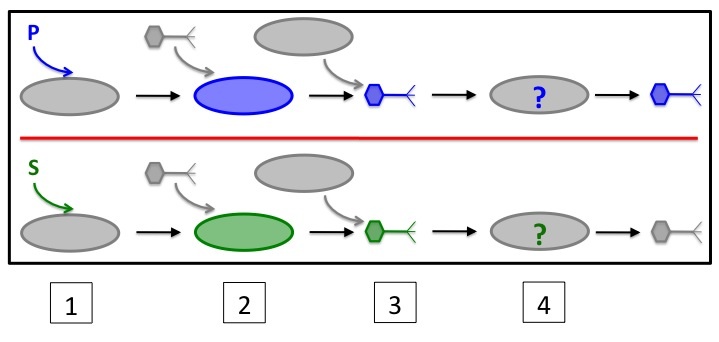
| MadSci Network: Genetics |
In Hershey Chase experiment to prove DNA is the genetic material it is said that since radioactive P is found in bacterial cell, it is the genetic material because it is passed on to that cell of bacteria.
But even the radioactive S containing protein is passed from bacteria to virus. So in this expt. if passing of something from one cell to another be the criteria to prove that it is the genetic material then even the protein should be called as genetic material. Why is it not?
Hi Mona,
This is an excellent question. Your question is focusing on the transmission of radioisotopes from bacteria to bacteriophage particles, but the key to understanding the Hershey-Chase experiment is the transmission of radioisotopes from bacteriophage particles to bacteria.
Before I go into that further, we have some answers in the archives that already discuss the Hershey- Chase experiment and the identification of DNA as the genetic material. Take a look at this answer (964701853.Ge) and this answer (1137125081.Mb).
I've drawn the cartoon figure below, which illustrates the experiment in four steps.

In step 1, bacterial cells (represented by the grey oval) are cultured on media containing either radioactive phosphorous (P) or radioactive sulphur (S). Phosphorous is a component of nucleic acids like DNA, and is not found in protein, whereas sulphur is a component of protein, and is not found in nucleic acids. So after growing on radioactive media, each culture of bacterial cells has either sulphur-radiolabeled proteins or phosphorous-radiolabeled nucleic acids.
In the figure, everything that has been phosphorous-radiolabeled is colored in blue, and everything that has been sulphur-radiolabeled is colored in green. Things that are not radiolabeled are colored grey.
In step 2, the bacterial cultures are infected with unlabeled bacteriophage particles. A bacteriophage particle infects the bacterial cell by transmitting its genetic material into the cell, and this directs the synthesis and assembly of new bacteriophage particles by the infected bacterial cells. These new bacteriophage particles are radiolabeled in accordance with the culture that was infected. A bacterial cell that was grown on radioactive phosphorus cannot produce sulphur-radiolabeled proteins, and a bacterial cell that was grown on radioactive sulphur cannot produce phosphorous-radiolabeled DNA.
This is where your question comes in. Both protein and DNA are packaged into new bacteriophage particles, and these molecules are made by the infected bacterial cells. So the bacteriophage particles produced from each radiolabeled bacterial culture will be radiolabeled, one set with phosphorous- radiolabeled DNA and the other set with sulphur-radiolabeled proteins, but we cannot yet tell which component of the bacteriophage, the protein or the nucleic acid, constitutes the genetic material.
In step 3, the radiolabeled bacteriophage particles are introduced to new unlabeled bacterial cultures. They again transmit their genetic material into the unlabeled bacterial cells. However, we still don't know if the genetic material is DNA or protein. I have drawn the resulting bacterial cells in grey with a green or blue question mark to reflect this uncertainty.
In step 4, those bacterial cells infected in step 3 produce new bacteriophage particles. What we want to know is if these new bacteriophage particles are phosphorus-radiolabeled or sulphur-radiolabeled. The result of the Hershey-Chase experiment was that only phosphorous-radiolabeled bacteriophage particles were found. This phosphorous-radiolabeled DNA came from the bacteriophage particles that infected these bacterial cells in step 3. Sulphur-radiolabeled protein is not transmitted to the new bacteriophage particles from the bacterial cells. This is what tells us that it is DNA (nucleic acid) and not protein that is the genetic material.
Remember that after step 1, all of the DNA in the top culture and all of the proteins in the bottom culture were radiolabeled. But by step 4, the only radiolabled molecules come from the bacteriophage particles generated at the end of step 2.
So, it is the third step of infecting unlabeled bacterial cells with radiolabeled bacteriophage cells that is key to understanding this experiment, and not the second step of infecting radiolabeled bacterial cells with unlabeled bacteriophage.
Keep asking questions!
Try the links in the MadSci Library for more information on Genetics.